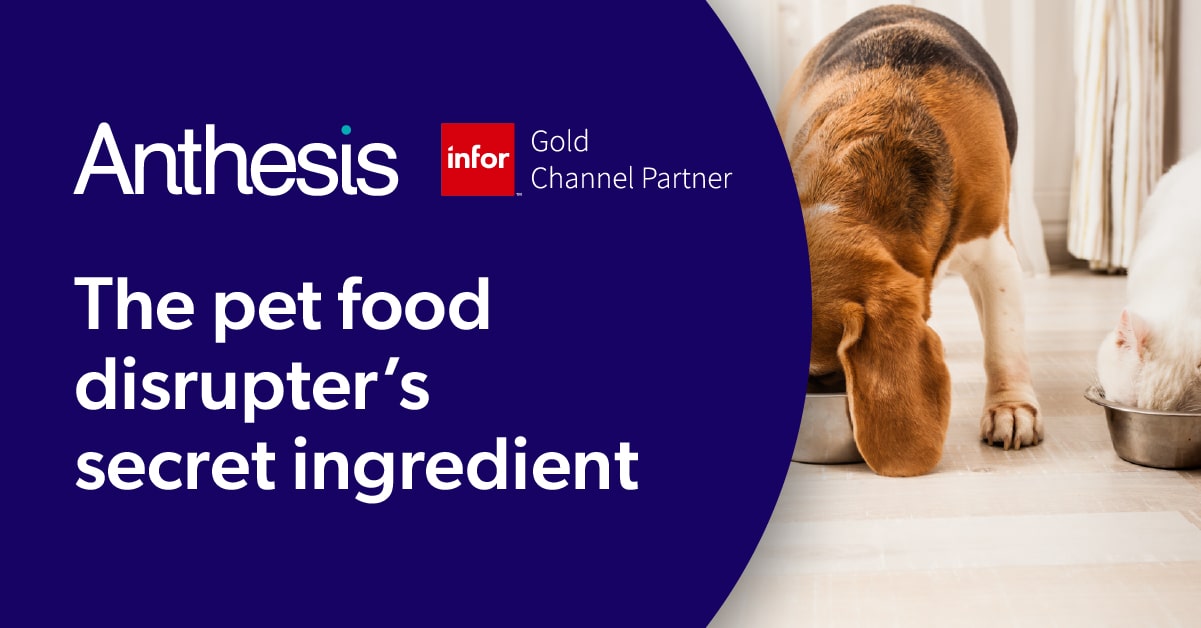The current UK and global pet food manufacturing marketplace is changing, with the rise of gourmet recipes and owners increasingly transferring lifestyle choices to their pets. Consequently, manufacturers have had to reorganise back-office systems, particularly the ERP software solution, to support emerging trends and respond to changing buyer behaviours.
To compete effectively, manufacturers must respond, adapt, differentiate and develop a more personalised service for customers. Furthermore, they must leverage their strengths, particularly their brand reputation and operational systems. Pet ownership has recently surged in the UK. According to the Pet Food Manufacturers’ Association, 3.2 million households acquired a pet since the pandemic started. As a result, the first lockdown saw further increases in sales as people stockpiled pet food. 37% of owners say they have prioritised earnings for their pets. The UK pet food industry is valued at £3.2 billion, and globally it is estimated to be $75.29 billion. (Mintel, 2021).
The humanisation of pet food
Analysts have suggested a trend for pet owners looking for personalised, quality products with a clear understanding of the source of ingredients. There are now a growing number of environmentally friendly and sustainable alternatives available too. For example; Dog food containing insects went on sale for the first time in 2019, and Vegan brands are increasing in popularity.
Owners are also starting to hold pet food manufacturers to the same quality standards as their own food purchases. They are looking for personalised, quality products with a known provenance of ingredients. Disruptive brands like Tails.com in the UK and Just Right by Purina in the US leverage customisation through tailor-made recipes. Other operators such as The Farmer’s Dog or The Barky Company focus on convenience. They offer pet food delivery services that resemble food subscription boxes such as Hello Fresh. Using data and leveraging personalisation tools used in the retail industry, traditional manufacturers need to fully understand the customer experience to provide a superior and effective customer experience. The maturing disruptor brands also need to adopt the platforms and tools necessary to support their continued growth.
Understanding data
Manufacturers must establish confidence that data generated by the business is:
- Well-governed. Not isolated in silos and inaccessible to the key stakeholders who need to make business decisions based on the data.
- Private and confidential with information that is adequately safeguarded and secure.
- Compliant – All regulatory, legal and ethical mandates are being adhered to properly.
The pillars of data integrity – data integration, data quality, data governance, location intelligence, and data enrichment – are fundamental prerequisites to achieving these objectives. This does not necessarily mean hiring an army of data analysts or scientists. Data needs the people, tools, and systems that can turn it into insights if manufacturers want to maximise the earning potential of their business. Ensuring data is integrated between CRM, order management and order history, the call centre or the content management system (CMS).
Mapping the data architecture and workflows within an enterprise is the first step to establish confidence in your data.
Building a direct-to-consumer (D2C) channel
Before introducing a D2C channel, determine the status quo and the intended destination:
- What is your company’s digital maturity level?
- Do you already have digital goals with corresponding visions?
- Should D2C be another strategy of the traditional pet food manufacturing company?
According to a Pet Food Industry survey, 63% of respondents said sales increases came from online retail channels. With another 51% explaining that pet food business is now looking closely at digital investments, with eCommerce sales, direct-to-consumer online sales or subscription and home delivery services.1
Some pet food manufacturers quickly pivoted their business model and set up D2C channels in Amazon. However, they found the infrastructure complicated to manage at scale. They didn’t have the technology in place to manage it efficiently. Additionally, the ERP system required additional components, which required expertise to set up which the business simply lacked. An alternative approach is to connect an eCommerce solution with the ERP and other business systems.
Build a community – use social media
People love talking about their pets and engaging with other owners. Pet food manufacturers need to encourage this behaviour. Invite customers and visitors to register their four-legged friends on the web and social media sites. Upload images and films of pets and share food and behaviour tips with other like-minded owners. The data generated is invaluable for customer relations, selling directly to customers, marketing, trend analysis, developing and testing new products.
Ultimately, manufacturers should collate and analyse customer data from all touchpoints. This will be needed to deliver individualised experiences across channels. Manufacturers can then increase engagement and drive conversions with personalised product recommendations based on customer behaviour.
Personalise, personalise, personalise
Today’s consumers have high expectations about their interaction with any organisation they buy from. The increasing digital touchpoints have led to highly personalised contacts with customers and prospects. However, an effective data-driven approach takes personalisation even further. It should adapt each interaction to the specific needs and preferences of the target audience. A data-driven customer experience can help to anticipate exactly what the customer wants. It can then present them with the most relevant content, products, or promotions .
To achieve this, manufacturers must break down internal data silos and develop strong and flexible integration capabilities. They need to consider adding contextual detail with location intelligence and data enrichment, learning more about the lifestyles, preferences, and important events in customers’ lives. The aim is to deliver highly personalised messages that get results.
Pet food manufacturers should also think about supporting the development of online pet health assessments. Such tools help owners ensure pets are healthy, happy and thriving. It also provides invaluable intelligence to the manufacturer about pet health and nutrition. The collected data could be integrated into all aspects of operations.
Conclusion
Like many developments in omnichannel retailing, pet food manufacturers must be prepared for the challenges that marry a consistent journey across various digital and physical channels. These may span research on mobile sites, social media engagement, buying a product in-store or supermarket, and interacting with customer support over various communication channels. The key is finding the right tool for the job. An easy-to-use ERP that can integrate with business systems and is designed with the challenges of the industry in mind. Understanding the experience journey of customers and seamlessly integrating it into the operational infrastructure of the pet food manufacturer will be vital.



